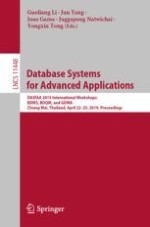2019 | Buch
Database Systems for Advanced Applications
DASFAA 2019 International Workshops: BDMS, BDQM, and GDMA, Chiang Mai, Thailand, April 22–25, 2019, Proceedings
herausgegeben von: Prof. Guoliang Li, Jun Yang, Prof. Dr. Joao Gama, Dr. Juggapong Natwichai, Yongxin Tong
Verlag: Springer International Publishing
Buchreihe : Lecture Notes in Computer Science
